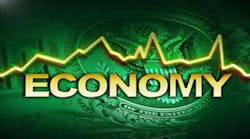WASHINGTON -- The U.S. economy ground almost to a halt in the first three months of the year amid severe winter weather, official data showed Wednesday.
Gross domestic product increased at an annual rate of 0.1% after hitting a 2.6% pace in the 2013 fourth quarter, the Commerce Department said.
It was the slowest growth since the last quarter in 2012. The slowdown was much sharper than expected, with most analysts having forecast a 1% pace.
Driving the slump were falling exports and business investment and a larger decrease in inventory investment.
Exports dived 7.6% after a 9.5% rise in the fourth quarter.
Another key factor was a modest slowdown in consumer spending, which accounts for about two-thirds of U.S. economic activity. Consumer spending increased 3%, slowing from a 3.3% rise in the fourth quarter.
Spending fell mainly on nondurable goods, like clothing and food and beverages, while it picked up for utilities and healthcare.
The Commerce Department did not comment on the reasons behind the slowdown, but the Federal Reserve has said that bad winter weather in much of the country was partly to blame.
The data came as the central bank's Federal Open Market Committee met for a second day of deliberations on monetary policy. The FOMC is widely expected to announce later in the day a cut of $10 billion from its bond-purchase stimulus program, bringing it to $45 billion a month.
Inflation was slightly more subdued in the first quarter, coming in well below the Fed's 2.0 percent target. Prices of goods and services bought by consumers rose 1.4% in the first quarter, slowing from a 1.5% gain in the fourth quarter.
Excluding food and energy, so-called core prices rose 1.4% after a 1.8% gain in the prior quarter.
A bright spot was higher personal income that offered hope for stronger consumer spending in the second quarter. The increase in disposable personal income -- income adjusted for inflation and taxes -- more than doubled to 1.9%. The savings rate fell.
The report is the first of three estimates on growth. Most analysts expect the economy will bounce back in the current second quarter.
"In short, weak growth and tame inflation, with growth even weaker than expected based on the monthly data," said Jim O'Sullivan, chief U.S. economist at High Frequency Economics.
But he said the monthly data have also signaled a pickup in growth later in the quarter and as the second quarter began.
"The pattern is consistent with the weakening being due in large part to weather effects and other sources of volatility rather than fundamental deterioration."
Copyright Agence France-Presse, 2014




